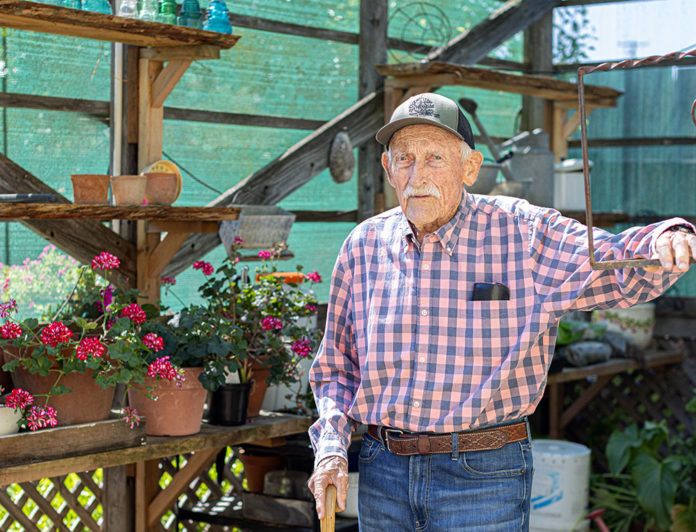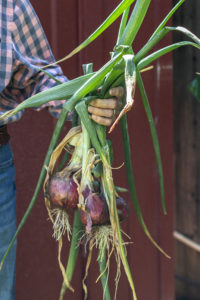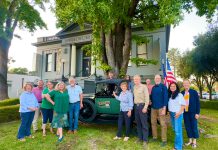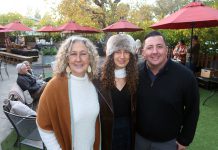
By Liza Gershman
The crumpled brown paper bag was heavy this morning—overstuffed with fresh onions, dirt still falling from the fist-sized bulbs, green stalks bent under their own weight. Dried prunes, sticky with summer. All a wonderful gift. “The best eggs in Healdsburg come from the chickens right here—free roaming—raised by Bob,” Ari Rosen mused. He had brought me to a garden on Chiquita Lane to meet a Healdsburg legend.

It takes a thousand conversations to uncover the source of this town’s most vivid flavors—like the mystery behind those bright, sunburst-orange yolks. They come from nonagenarian and gardener extraordinaire, Bob Brock … shhhh, don’t tell.
Healdsburg is full of food secrets. Someone knows who has the best mulberries (the word on the street is Preston and Millbrook Farms). Someone else swears by the broccoli at Noble Goat. There’s a bee person everyone keeps telling me I have to meet—and a seed guy, too.
We wandered the garden on Chiquita Lane, which runs alongside an open field at the base of a gentle hill—the kind of unplanted land rarely seen in Sonoma County anymore. Grape vines and new houses now cover much of what once felt wild and raw. This particular field, owned by the Dry Creek Rancheria Band of Pomo Indians, is used for grazing cattle. It’s one of the last open unplanted stretches in the area.
Bob moved through the vegetable rows with focused energy, excited to tell me about every plant. Born in Kansas, he came west in 1944. Years later, while running a nursery in Los Angeles with his wife, Cathy, Bob began duck hunting in the valley and made friendships that tethered him to this life. Eventually, the land called them north. As we walked through the intimate yet robust garden, his movements were unhurried but purposeful, shaped by seasonal rhythm. He still tends the plants, flowers, chickens and bees each day—and, as Ari said, it is symbiotic: The garden tends to Bob.
Inside the ranch-style home on Chiquita Lane, slices of Costeaux’s cinnamon walnut bread were passed around—a lovely treat. I ate a dozen dried pears from the season before, candy-sticky and soft, followed by leathery, bright persimmons (dried and waiting to become cookies) pulled from the fridge. Cathy served thick, bright-yellow, home-made butter from a friend’s dairy up north, its richness still lingering on my tongue. As the flavors unfolded, Bob shared memories about Bistro Ralph’s, Felix and Louie, and Healdsburg 20 years ago. A flavor memory returned and I could taste it again—a savory stack of a thousand French fries, salty and hot, just like they used to serve.

The food on the table that morning felt like history carried in seeds and soil, in bees and hands. Healdsburg’s food culture is rooted in many lineages—Native, Italian, agrarian and restaurant-born—and the symbiosis among them still defines the town. Everything we ate had been grown, made or shared nearby. That kind of connectivity holds, even as prices shift and seasons turn.
Bob opened his freezer to show rows of duck, hunted with friends and packed away for winter. It brought back memories of classmates who carried wild boar jerky to school, made the night before from animals their families had hunted in the hills. That kind of living still exists—sustainable, quiet, enduring.
The Brocks’ onions and eggs go to Ari’s kitchen. Their raspberries find their way into a neighbor’s pie—a pie Bob says is “so good it will break your heart.” That neighbor, raised in the Midwest and taught to cook in her grandmother’s farm kitchen, reveals one mystery. The secret is in the layering: half the berries cooked down, the rest added raw just before baking.
The result is tart, bright, and fresh—each bite still tasting like the fruit it came from. She stopped by that morning, too. Bob and Cathy are something of a quiet culinary epicenter, an open door, with neighbors and friends drifting through the garden and into the kitchen.
Without those thousand conversations, how do the hidden mysteries of Healdsburg’s food come to light? The farmers’ market brings it all into view—where growers, cooks and neighbors share what they know best. In Healdsburg, food isn’t separate from community. It’s what binds everything together.
Do you have a recipe that tells a story? We’re looking for family favorites, seasonal treasures and dishes that celebrate our region’s rich food culture. Selected recipes and cooks will be featured in the upcoming book “Farm + Market: Healdsburg.” Submit to healdsburgbook.com.








